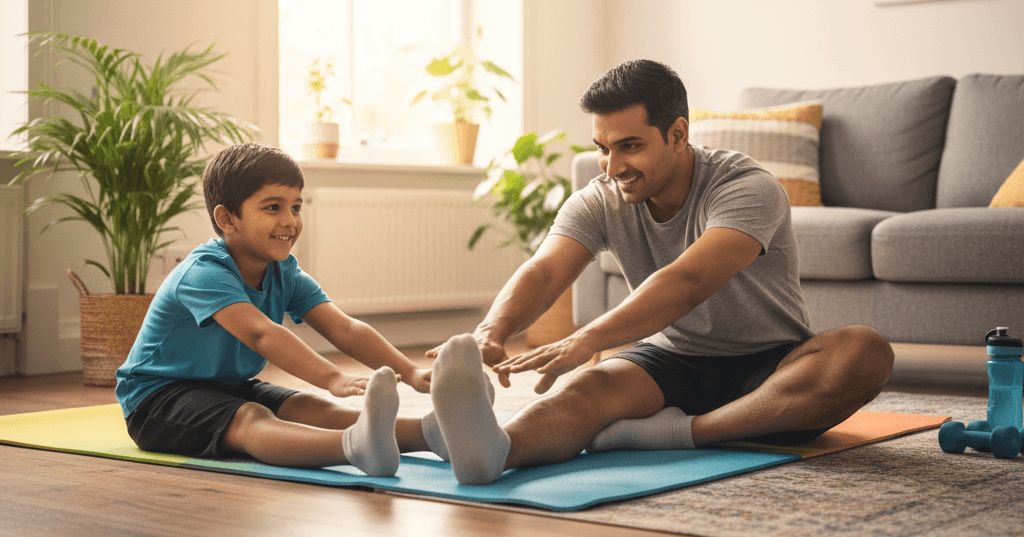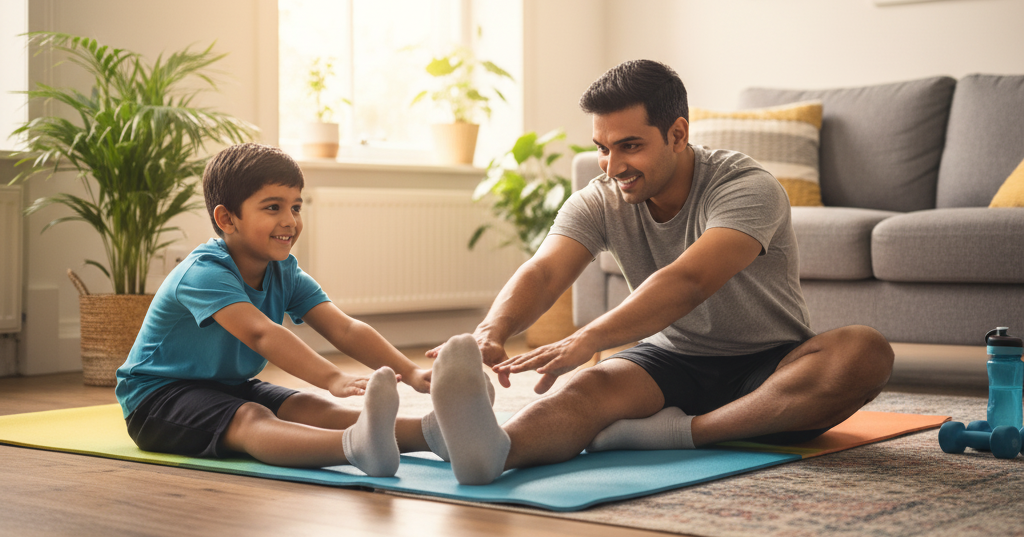
Simple Exercises For Kids To Do At Home

Encouraging physical activity for kids is crucial for their growth and development. Regular exercise improves physical health, enhances mental well-being and fosters a lifelong habit of staying fit. With the help of various simple and fun exercises, kids can get fitter in the comfort of their homes, without the need for expensive equipment or large spaces. Running, jumping, or playing imaginative games helps children channel their energies and strengthen vital skills. Let’s dive into some creative ways to keep kids active and entertained!
Running
Running is one of the easiest forms of exercise, making it ideal for kids who have a lot of energy and love to move fast. Kids can run almost anywhere, whether it’s outside on the grass or inside around a big table. Running can also be mixed with other activities to create fun games, like relay races.
To keep things interesting while running, encourage kids to change their movements. They can switch from running to skipping or try running in place with their feet barely touching the ground, known as “fast feet.” Changing directions, like moving side-to-side or backward, helps develop both muscle strength and coordination, benefiting their overall physical skills.
Jumping
Get those feet off the ground with these simple jumping exercises! Jumping helps build muscle strength, improve cardiovascular health, and increase endurance. It’s always great fun to see who can jump the highest amongst friends, siblings, or even parents!
Here are some fun jumping activities for kids to try:
- Criss-cross feet: Jump straight up and cross one foot in front of the other. On the next jump, switch feet and keep going.
- Hurdle hops: Jump side-to-side or front-to-back over an imaginary hurdle.
- Jumping jacks: While jumping, stretch your arms and legs out to the sides like a starfish. On the next jump, bring your arms back to your sides and legs to the centre.
- One-foot hops: Lift one knee and jump on the standing leg, then switch. This is also a great way to practice balance!
- Tuck jumps: Bend your knees and lift your heels high while jumping.
Also read: Why a Consistent Bedtime Routine is Crucial for Kids’ Development
Make Workouts Fun with Games
To make workouts more enjoyable for kids, turn it into a game. Here are some suggestions from Akpan.
Corners: Split the kids into groups, giving each one a “home corner.” They will run around the room in a circle, and when you give the signal, they must rush back to their corner and perform a few simple exercises, like five jumping jacks or holding a plank for 30 seconds. Akpan recommends allowing the kids to choose the exercises for their corners, which gives them a sense of control over the game.
Go back and hit it: When you say “go,” the kids sprint forward in their assigned lanes. Then, when you shout “back,” they need to run backwards. Finally, when you say “Hit it!” they should add another skill, like a tuck jump or a squat.
Squat relay: Have the kids line up on opposite sides of the room, facing each other. When you say “go,” they all run to the centre and meet. They must perform three squats, giving each other high-fives with both hands between each squat. After that, they return to their starting positions and do it again.
Traffic: This game is like “red light, green light,” but with more action. Kids will stop and start at red and green lights, shuffle sideways for yellow lights, do bunny hops at speed bumps, link arms to run with a partner for a “carpool,” and gallop when you say “deer crossing.” Encourage your kids to come up with even more moves!
Creative Indoor Ball Activities
Playing ball games, whether indoors or outdoors, can provide excellent exercise for kids. Benefits include aerobic activity, balance, and coordination practice. Plus, kids are often drawn to any game that involves a ball.
Here are some examples of indoor ball games that don’t need much space:
- Tossing balls into laundry baskets
- Hitting balls at a target using a household item
- Catching balls with a plastic mixing bowl
- Throwing, rolling, or kicking a ball against the wall
Skipping for Better Balance
Skipping is an enjoyable aerobic exercise that also helps improve balance and coordination skills.
Here are some fun skipping games to try out:
- Hopscotch: Create a hopscotch grid using chalk outside or masking tape inside. Players take turns tossing a small object, like a beanbag, onto one of the squares. The goal is to hop, skip, or jump through the squares without stepping on the one with the object.
- Jumping rope: Have your kids jump rope for a set amount of time. You can make it more challenging by having them jump forward and backwards, or turn it into a competition to see who can get the most skips in that time.
- Obstacle course: Design a simple obstacle course using everyday items, like a chair to skip around and a pot to jump over. Time your kids as they try to beat their best scores.
- Skipping tag: Play tag, but instead of running or walking, everyone skips to catch each other. You can mix it up by having them hop on one foot, crawl on all fours, or use other fun movements.
Also read: How Much Sleep Do Kids Really Need? Age-Wise Sleep
Crab Walk
The crab walk is a fun activity that helps kids strengthen their core and arms, and it can lead to some giggles too.
Start by showing your kids how to do the crab walk (keeping their torso and tummy up while moving on their hands and feet with bent knees). Then, create fun challenges for them to complete while in this position.
Here are some ideas:
- Balancing act: Have the kids balance objects like a stuffed animal or a plastic cup on their stomachs and see who can go the farthest without dropping it. You could also challenge them to see how many stuffed animals they can balance while holding the pose.
- Obstacle course: Set up an obstacle course for them to navigate while crab crawling.
- Race: Get ready, set, and crab crawl to the finish line!
Bear Crawl
The bear crawl involves moving on all fours with your stomach facing the ground, which is the opposite of the crab crawl. This exercise is great for engaging the entire body and encourages kids to use their arms, legs, and core muscles.
Start by having kids practice the bear crawl, then introduce it into more complex activities, like obstacle courses or races to a specific spot in the house and back.
With some caution, they can also jump over each other’s backs while in this position.
Build Strength with Squats
These straightforward exercises help build leg strength, providing kids with a solid base for various sports and fitness activities.
You can try forward, backwards, and side lunges, along with traditional squats. Turn it into a fun game by counting how many they can complete in 30 seconds while maintaining good form.
Make sure their knees stay aligned with their feet and don’t bend too much.
You can add jumps to the squat routine by having kids hop every time they rise between repetitions.
Sit-Ups and Push-Ups
For older kids, basic exercises like sit-ups, push-ups, and planks are excellent for getting them moving and strengthening their core. They can try different types of sit-ups, such as traditional crunches, bicycle crunches, and leg-up sit-ups.
Kids can also learn how to do basic push-ups and planks to enhance their upper body and core strength. If needed, they can modify push-ups by keeping their knees on the ground.
Like squats and lunges, these exercises can be incorporated into games and other activities (like circuits and races) to keep kids interested and having fun. These workouts are also beneficial for kids looking to build strength for sports or dance teams they are part of.
Also read: Healthy Snacks for Kids: Nutritious and Tasty Options
Relax and Stretch with Yoga
Yoga can be an enjoyable and easy way for kids to get some exercise. Some fun and simple poses for them to try are tree pose, downward-facing dog, cobra, child’s pose, and happy baby. Additionally, the soothing aspect of yoga can help your child clear their mind.
After finishing yoga, it’s a good idea to do some basic stretches to keep their muscles strong and healthy. A stretching routine and cool-down can also help kids relax after their workout and reduce the risk of injuries.
Some stretches to consider include side stretch, hamstring stretch, fingers-to-toes, arm circles, reaching arms to the sky, calf stretch, and runner’s stretch.
Conclusion
Incorporating exercise into a child’s daily routine can be enjoyable and rewarding for the entire family. Kids can develop strength, coordination, and confidence while having fun with engaging activities like skipping games, yoga poses, and imaginative relay races. These exercises benefit their physical health and create opportunities for bonding and shared laughter. By making fitness exciting and accessible, you can help nurture a love for movement that lasts a lifetime.
So, let the fun begin, and watch your little ones thrive!
Found this helpful?
Share this article with other parents who might benefit from this information.